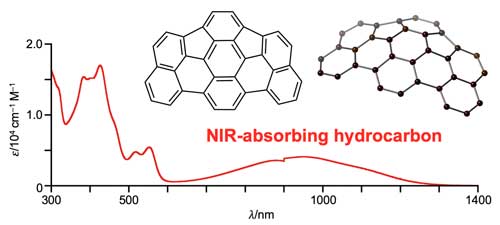| Oct 20, 2020 | |
Molecular design strategy reveals near infrared-absorbing hydrocarbon(Nanowerk News) Nagoya University researchers have synthesized a unique molecule with a surprising property: it can absorb near infrared light. The molecule is made only of hydrogen and carbon atoms and offers insights for making organic conductors and batteries. |
|
| The details were published in the journal Nature Communications ("as-Indaceno[3,2,1,8,7,6-ghijklm]terrylene as a near-infrared absorbing C70-fragment"). | |
 |
|
| as-indacenoterrylene is a bowl-shaped compound made only of hydrogen and carbon atoms that can absorb near infrared light. (Image: Nagoya University) | |
| Organic chemist Hiroshi Shinokubo and physical organic chemist Norihito Fukui of Nagoya University work on designing new, interesting molecules using organic, or carbon-containing, compounds. In the lab, they synthesized an aromatic hydrocarbon called methoxy-substituted as-indacenoterrylene. This molecule has a unique structure, as its methoxy groups are located internally rather than at its periphery. | |
| “Initially, we wanted to see if this hydrocarbon demonstrated novel phenomena due to its unique structure,” says Fukui. | |
| But during their investigations, the researchers discovered they could convert it into a new bowl-shaped hydrocarbon called as-indacenoterrylene. | |
| “We were surprised to find that this new molecule exhibits near infrared absorption up to 1300 nanometers,” Shinokubo explains. | |
| What’s unique about as-indacenoterrylene is not that it absorbs near infrared light. Other hydrocarbons can do this as well. as-indacenoterrylene is interesting because it does this despite being made of only 34 carbon and 14 hydrogen atoms, without containing other kinds of stabilizing atoms at its periphery. | |
| When the scientists conducted electrochemical measurements, theoretical calculations, and other tests, they found that as-indacenoterrylene was intriguingly stable and also had a remarkably narrow gap between its highest occupied molecular orbital (HOMO) and its lowest unoccupied molecular orbital (LUMO). This means that the molecule has two electronically different subunits, one that donates and another that withdraws electrons. The narrow HOMO-LUMO gap makes it easier for electrons to become excited within the molecule. | |
| “The study offers an effective guideline for the design of hydrocarbons with a narrow HOMO-LUMO gap, which is to fabricate molecules with coexisting electron-donating and electron-withdrawing subunits,” says Fukui. “These molecules will be useful for the development of next-generation solid-state materials, such as organic conductors and organic batteries.” | |
| The team next plans to synthesize other near infrared-absorbing aromatic hydrocarbons based on the design concepts garnered in this current study. |
| Source: Nagoya University | |
| Share this: | |
|
Subscribe to a free copy of one of our daily Nanowerk Newsletter Email Digests with a compilation of all of the day's news. |
|
